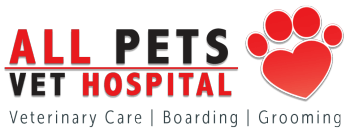As veterinarians, we witness the heartwarming bond between puppies and their families every day. Yet, lurking beneath the playful nips and joyful tail wags, a serious threat often overshadows these early days: parvovirus.
This highly contagious and potentially deadly illness can devastate unvaccinated puppies, especially younger ones. That’s why we’re passionate about equipping puppy owners with critical knowledge about parvovirus that can empower them to prevent illness and act swiftly should symptoms arise. In this blog post, we’re sharing the basics about parvovirus in puppies to help you protect and care for your new canine companion. Keep reading to learn more, and if your pup is sick, we encourage you to seek professional veterinary care right away to ensure the best possible prognosis.
What Is Parvovirus?
Canine parvovirus is an extremely contagious and sometimes fatal viral disease that attacks the gastrointestinal tract of dogs, primarily puppies under six months old. It’s caused by canine parvovirus type 2 (CPV-2), a resilient virus that can survive on surfaces in the environment for weeks or even months, making it particularly difficult to control. It is especially active in the spring and summer but can infect pets year-round.
Parvo, as it is commonly called, spreads through contact with infected feces, contaminated objects, or even the hands and clothing of people who have been in contact with an infected dog. Once inside a dog’s body, the virus attacks the rapidly dividing cells in the intestinal lining, disrupting their ability to absorb nutrients and fluids.
While parvovirus is a scary disease, it’s important to remember that it is preventable with vaccination. Responsible dog ownership practices, such as avoiding high-risk areas and practicing good hygiene, can also help reduce exposure risk.
.jpg)
Most At-Risk Puppies
The youngest and most vulnerable puppies are at the highest risk of contracting parvovirus. Unvaccinated puppies under six months, particularly those under three months, are prime targets. Maternal antibodies begin to wane around six weeks, leaving pups susceptible until their own immune systems have time to develop. Additional factors like immunosuppression and co-infections can also increase risk.
Recognizing the Warning Signs
Early detection is crucial in the fight against parvovirus. As a pet parent, it’s important to familiarize yourself with the classic symptoms.
The symptoms of canine parvovirus in puppies include:
- Severe, projectile vomiting: Often containing blood or bile, occurring frequently and forcefully.
- Foul-smelling, bloody diarrhea: May appear watery or mucoid, often with a distinct offensive odor.
- Extreme lethargy: A marked lack of energy, appearing weak and disinterested in usual activities.
- Loss of appetite: Refusal to eat or eat very little, even tempting treats.
- Fever: Elevated body temperature, often accompanied by shivering or discomfort.
- Abdominal pain: Whining or yelping when touched near the belly, indicating discomfort.
- Dehydration: Dry gums, sunken eyes, and lethargy can all point to dehydration.
Remember, parvovirus strikes quickly. Any combination of these symptoms, especially in young, unvaccinated pups, warrants immediate veterinary attention. The longer you wait to contact a veterinarian, the lower the chances of successful treatment. Parvovirus is a devastating disease, but the earlier your veterinarian begins supportive care, the better your pet’s chance of recovering.
Diagnosis and Treatment
Prompt diagnosis is key to providing the best possible care. Since young puppies are relatively delicate — especially before they’ve received all of their vaccines — we recommend seeking veterinary care if you have any reason to think your furry friend may be feeling under the weather. It’s best to err on the side of caution when it comes to something as precious as your companion’s life!
If parvo is suspected, your veterinarian will likely perform a physical exam, fecal test, and possibly a rapid diagnostic test to confirm the presence of the virus. There is no cure for parvovirus, but veterinarians provide supportive care to help patients recover. target="_blank"Sanitizing and disinfecting the environment is important after diagnosis!
Treatment for parvovirus focuses on supportive care, including:
- Hydration: Rehydrating through intravenous fluids and electrolytes to combat dehydration and electrolyte imbalances.
- Vomiting control: Antiemetics to manage nausea and vomiting, reducing further fluid loss and discomfort.
- Pain relief: Medication to alleviate abdominal pain and improve comfort.
- Antibiotics: Sometimes used to combat secondary bacterial infections, and in severe cases, antiviral medications might be considered.
.jpg)
Prognosis and Recovery
Parvovirus is a formidable foe, but with early intervention and aggressive supportive care, the odds of survival are significantly higher. However, the road to recovery can be long and arduous, with complications like intestinal damage and secondary infections still posing a threat. Studies show that up to 90% of puppies can overcome parvovirus with proper treatment. However, roughly 90% of untreated dogs do not survive. This emphasizes the importance of seeking immediate veterinary care if your puppy shows any symptoms of this devastating illness.
Prevention: The Best Offense
The best defense against parvovirus is a vigilant offense. Vaccination is the cornerstone of prevention. Starting at 6 to 8 weeks old, puppies should receive a series of parvovirus vaccinations, with boosters at regular intervals to maintain immunity. Responsible dog ownership also plays a crucial role in protecting your pet.
Other ways to protect your pet from parvo include:
- Schedule regular vet checkups: Ensure timely vaccinations and receive expert guidance on preventing parvovirus and other diseases.
- Minimize high-risk areas: Avoid dog parks and areas with unknown vaccination histories until your puppy is fully vaccinated.
- Practice good hygiene: Regularly clean and disinfect puppy toys, bowls, and bedding to reduce the risk of virus exposure.
Conclusion
Parvovirus may be a formidable opponent, but with awareness, prompt action, and preventive measures like vaccination, puppy owners can confidently navigate this potentially devastating disease. Remember, knowledge is power. Seek guidance from your veterinarian, prioritize vaccinations, and remain vigilant for any early warning signs. Together, we can ensure that puppyhood is filled with joy, not fear.
If you have questions and you'd like to reach out to us, you can call us directly at 908-707-1555, or you can email us at [email protected]. Don't forget to follow us on social media Facebook, https://www.instagram.com/allpetsvetnj/" target="_blank">Instagram.


